Copyright information
All of these pictures are copyright © 1980-1999 Stephen M. Dunn.
You may view these pictures for your own personal enjoyment, and you
may print one copy of each for your own personal enjoyment. You may
not redistribute, edit, or sell these pictures, or use them in any
manner other than as permitted above, without prior consent from me.
Introduction
Pointing a camera at something and pressing the shutter release button
is easy. Getting a good picture, however, is not always so easy.
This brief collection of tips is intended to show a few techniques
and pitfalls. I've included some of my own pictures which illustrate
the points. Some of these pictures are not really great pictures,
but they show what I'm talking about.
These tips are more technical than artistic. Also, this isn't
anywhere near a complete list of techniques that might be useful.
If you're interested in photography, I strongly urge you to read
books and magazines, and consider taking courses. Many schools,
colleges, and universities offer photography courses ranging
from introductions for casual users through full-fledged
degrees.
There are lots of photography resources on the Net. One
that I find particularly useful is
photo.net, where you'll
find pictures, equipment reviews, tutorials, and discussion
databases.
Table of Contents
Fill the frame with your subject
If you're taking a picture of something, you have to decide how much
of the frame your subject should fill. Sometimes you want to show
the subject and its surroundings; other times you want to show
the subject and nothing else.

|
The subject of this picture is the jaguar. The surroundings really
aren't important. A tight composition makes it perfectly clear what
the subject is. Also, given that film and photographic equipment have
their limits, you tend to see more detail. In the case of a prowling
jaguar, there's also a sense of tension - the cat is right in your
face and may be ready to pounce!
|
Use fill flash to reduce contrast
Many people use flash if it's dark, and don't use flash if it's light.
However, there are times when flash is useful even in well-lit
situations. One use is to reduce the contrast in a scene. The human
eye can easily handle a scene with a wide range of contrast. Film,
on the other hand, can't. If you take a picture of a scene with a
wide contrast range, you'll find that shadows and highlights turn
to featureless black and white, respectively, even though your eye sees
detail in both. Flash can help reduce the contrast in the scene
so that your film can capture more detail. It can also help get
rid of distracting shadows.
| No fill flash |
Fill flash |
|
|---|

|

|
The first picture was taken without flash. Note now prominent the
shadows across the jaguar's face and body are. The shadows distract
the viewer's eye from the subject and reduce the level of detail visible.
The second picture uses fill flash to reduce the shadows, yielding a
much more pleasing picture.
One unfortunate consequence of shooting pictures in zoos is that
there are often cages in the way (go figure!). Fill flash sometimes
makes the cage bars more prominent in the picture. In the first
picture, you really can't see them. In the second, you can see a grid
of slightly lighter patches running horizontally and vertically;
that's the cage reflecting flash back at the camera. If you can get
the camera right up against the enclosure, you can get rid of these,
but usually there's a fence preventing humans from getting right up
to the edge of the cage so that people don't do silly things like
sticking their hands into the jaguar's cage to try to pet it, so if
you want to use fill flash, you have to put up with the cage
reflecting it back at you.
|
Use fill flash to enhance detail
Fill flash can also bring out detail in pictures.
| No fill flash |
Fill flash |
|
|---|

|

|
The first picture was taken without flash. It's pretty enough.
But the second picture's colours are a little bit more lively.
You can also see the stem, which was in shadow in the first picture.
|
Keep the horizon level
Unless you're certain that a picture would look better with
the horizon on a funny angle, keep it level. The same applies
to anything that you would normally expect to be horizontal or
vertical; if it's at an odd angle, the picture will generally not
be pleasing.

|
This picture just doesn't feel right because the bridge and the
surface of the water below it, which should be horizontal, are not.
|
What shutter speed should you use?
The human eye doesn't have a choice of shutter speeds. Many
cameras, however, do, and you can take two pictures of the same
subject, at different shutter speeds, and get different results.
Here are some guides for a few types of pictures:
- Fast-moving subjects: You have a choice here. If you
pick a fast shutter speed, you can freeze the motion and render a
nice, sharp image. On the other hand, if you use a slower shutter
speed and pan (smoothly move the camera so that it follows the
subject's motion), you get a strong impression of motion because
the background will be streaked. Many good photography books
will give a table suggesting the minimum shutter speed needed to
freeze various types of subjects, depending on how quickly they're
moving and the angle of motion relative to the camera.
- Aircraft in flight: For propeller-driven planes and
helicopters, you don't want a shutter speed that's too fast,
or else you'll end up freezing the motion of the propellers, and
a picture of a plane in mid-air with its propeller not moving looks
very unnatural. Otherwise, use a high shutter speed to ensure a
sharp image.
- Moving water: Again, there's a choice. A fast shutter
speed will freeze the motion of the water. A moderate shutter
speed will produce an image with a bit of blur, similar to the
way humans perceive moving water. A slower shutter speed will
turn moving water into a blur with streaks showing the direction
of motion. A very slow shutter speed (several seconds) will
produce an interesting effect on the water's edge if there are
waves; you'll get a misty effect. Some people love some of
these effects, and some people hate them; decide for yourself.
Of course, for longer exposures, you'll need a tripod.

|
This picture was taken at a relatively slow shutter speed (probably
around 1/30); the falling water has turned into a blur.
|

|
This picture was taken at a much faster shutter speed (perhaps
1/500 or faster). The picture shows the water in a way the human
eye can't. What we normally perceive as a sheet of water
actually isn't.
|
Flash falls off over distance
Flash is a wonderful tool, but it has its limitations. One of these
is that the intensity of light from a flash falls off as the square
of the distance from the flash. That means that if a subject that's
3m away has correctly illumination, a subject that's 1.5m away
has four times too much light on it, and a subject 6m away has
only a quarter of the light it needs. This means that flash isn't
very good at illuminating scenes that have a lot of depth.

|
Toby received reasonably constant illumination, as the farthest part of his
body is not much farther from the flash than the nearest part of
his body is. But look at the comforter. In front of Toby, it's
quite bright. Not far behind him, it's rather dark.
|
Flash causes redeye
Your retina (the area at the back of your eyeball where images
are formed) is red. Normally, you can't see this, because it's
not all that well illuminated; if it's bright, the pupil contracts
and not much light gets in and out, and if it's dark, there's not
enough light to see the retina. However, if you use flash to
take a picture of someone in the dark, their eyes may turn red,
because their pupils are wide open (due to the poor light), and the
light from the flash reflects off the retina and back out. The
same thing happens with animals, although their eyes often glow
different colours.
To reduce redeye, consider the following:
- Use redeye reduction if your equipment allows it - many
camera flash units can reduce redeye. Some do this by emitting a
flash a bit before taking the picture; this causes the pupil to
contract, reducing the amount of light that gets to the retina
and reducing the amount that bounces back out. However, many people
find this objectionable, and you'll often have your subject think that
you took the picture and break their pose; you end up with a photo
of them turning away. Some others use a constant beam for a second
or two. If the subject looks at this beam, it works. If they don't
(e.g. a baby or an animal who cannot follow verbal instructions),
it doesn't.
- Increase ambient illumination - if you have control over
the lighting in the area where you are taking the picture, increase
the light level. The subject's pupils will contract and you won't
get redeye.
- Move the flash away from the lens - the greater the
angle between the flash and the lens, the less likely you are to
get redeye. If you have the choice between using a built-in flash
unit and an accessory flash unit that mounts on top of the camera,
use the latter.
- Use bounce flash - if the ceiling is white and not too high,
and if your flash unit allows you to tilt it up, bounce the light
off the ceiling. This also tends to soften the light and produce
nicer pictures; however, it can also cast shadows below features
such as eyebrows and noses. If the ceiling is not white, the
light from the flash will take on whatever colour the ceiling is,
which may not be what you want. Also, bouncing reduces range
dramatically; not only does the light have to travel farther, but
it's also scattered by the ceiling.

|
Cats' eyes are among the worst for this, since they're highly
reflective. The colour of the cat's retina can sometimes appear
on the fur surrounding the eye, because the light reflecting
from the retina partially illuminates the fur.
|
Watch out for oddly-coloured lighting
Have you ever noticed that different types of lights put out different
colours? We notice these things, but we perceive them to be
subtle, and we rapidly adjust so that we no longer see the odd colours.
Film, however, not only lacks the ability to adjust, but also
tends to enhance the colour. If you are shooting slide film, you'll
need to use filters to compensate during exposure. If you shoot
print film, you may be OK; the lab may be able to compensate during
printing. However, if you have multiple light sources in the same
image, you'll have problems; some parts of the image will have one
colour, and some another. There are sometimes things you can do
about this (for example, if you're using flash, you can put a filter
on the flash to make it a similar colour to the other light
source), but if possible, try to avoid these situations.

|
Fluorescent lighting is among the worst offenders. There are numerous
types of fluorescents, and each has a slightly different colour.
But they generally turn out a sickly greenish colour when photographed.
Note now the carpet in the foreground changes tone from beige at the
very front (illuminated partly by sunlight and partly by flash) to
green near the tiles (illuminated mostly by fluorescent light).
|
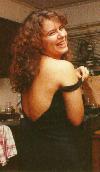
|
Incandescent light is yellow. This can sometimes add a nice warm
colour to skin.
|
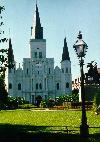
|
Look carefully at the building. It's supposed to be white, but it's
actually slightly blue. Why? It's in shadow, and being lit by the
sky rather than by the sun. Since the sky is blue, shadow areas
tend to take on a blue colour. A skylight filter could have fixed
this; skylight filters are slightly pink, to compensate for the
blue tone of skylight.
|
Enhance the sense of depth
The world is three-dimensional; it has real depth. A photograph
is two-dimentional; it's flat. Some scenes require a feeling of
depth in order to be successful. Here are a few techniques
which may help:
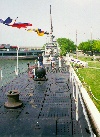
|
Have lines leading from the foreground to the background - these
lines will converge towards the horizon. Since this is the way lines
work in the real world, we automatically perceive depth.
|

|
Place objects in the foreground and in the background - this
gives us a point of reference. The pebbles in the foreground look
quite large. The pebbles a bit farther back look smaller. The trees
are narrower than the pebbles. Since we all know that trees are
much bigger than pebbles, we perceive the trees to be much farther
away. If this picture didn't include the pebbles, it wouldn't have
the same sense of depth.
|

|
Use fog or mist - in the real world, when it's misty or foggy,
objects that are farther away are less distinct than objects that are
closer. If we see the same effect in a photo, our minds automatically
assume the same cause - the foggy part is farther away.
|
Frame your image
Having something in the foreground which complements the image, or
even is part of it, can make the whole image more appealing.

|
The stone arch in the foreground is part of the abbey. It helps give
the image a sense of scale.
|

|
The trees in the foreground are not part of the scene, but they
complement it since much of the background is forested. They
also provide a certain sense of depth, since it's easy to compare
the size of the trees making the frame to the background trees.
|
Don't put the subject right in the center
Try dividing the frame into three sections horizontally, and three
sections vertically. Place the subject on one of the lines, or
even at one of the intersections. If the subject is looking or moving
in one direction, place it so that it's looking or moving in the
direction where there is open space.

|
The sailboat is moving to the left. It's positioned well to the
right, to give the impression that it has somewhere to go.
|

|
The man with the bagpipes is facing towards the open space. Also,
framing the subject this way leaves room for the children. The picture
is much more interesting if there's an audience for the piper, and
including the children answers the question "What is this man
looking at?"
|

|
Show where the canoe is going, not where it's been.
|
Try a different view of a familiar subject
This is particularly the case when on holiday. If you've gone somewhere
popular, everyone will have either been there, or seen pictures from
there. Try to find a shot of something that everyone has seen, but
from an angle that isn't as common.

|
Most pictures of waterfalls are taken from downstream. Try one
looking across the crest instead.
|

|
Or try using the river downstream of the falls as the focal point,
with the falls leading into the river.
|

|
Everyone takes pictures of momuments and buildings from the ground,
looking up. As a result, they converge towards the top and look
distorted. Can you get closer to level with your subject?
|

|
If you're taking a picture of something low to the ground (for example,
a pet or a child), get down to its level.
|
Use people to establish scale
If you're taking a picture of something really large, or really
small, it doesn't necessarily look really large or really small
unless you provide a nearby object of familiar size. People work
well, but you can use anything that gives a recognizable scale.
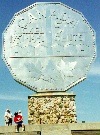
|
How big is this Big Nickel? Without the people, you'd have no idea.
With people in the corner of the image, though, you can see just how
big this coin really is.
|
Use sidelight
Using light that comes from the side of the subject, rather than
above or from the front, can do a few things. It tends to emphasize
surface texture by casting shadows. You have to pick your spots for
this one; for example, for portraits, you want to be careful about
showing the texture of a person's face unless they have really good
skin, and be careful with the shadow their nose will cast. But
it's good for inanimate objects where the texture is important,
and it can also add mood to a picture.
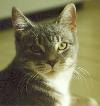
|
I like this effect, although I should probably have used a bit of light
from the front, or the other side (using the kitchen door as a reflector)
to add a bit of light.
|
Since 27 September 1999,
 people have viewed this page.
people have viewed this page.
Return to photo page
Return to home page


